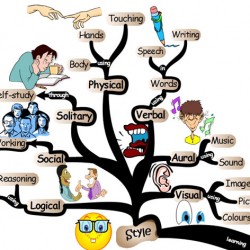Yesterday one of our customers asked about the difference between “learning” and “adult learning.” I was tempted to say there is no difference (just to get the discussion going – and, in a sense, demonstrating adult learning techniques). Instead, I grabbed a couple of colored markers and started listing elements of learning on the whiteboard (also sneakily using adult learning techniques). Here is a high-level summary that you are free to use, the next time you are discussing adragogy with your friends or neighbors…
You probably have heard of the “right brain / left brain” concept. It is generally-believed that different sides of the brain handle different types of thought processing:
Right Brain = intuitive, creative, spacial
Left Brain = logical, analytical, verbal
Actually, when discussing learning styles, preferences, and teaching techniques, you can break these down into finer detail:
- Verbal = reading, speaking, writing
- Visual = pictures, graphics, maps, colors, formatting
- Auditory = sound, rhyme, rhythm, music
- Kinestetic = touch, action, movement, position, location in space
(…hang in there, we’re going somewhere with all this…)
Accelerated Learning is engaging “all” (or as many as is reasonable) of these above-mentioned perspectives in the learning and teaching process. So key elements of Accelerated Learning are:
- using all learning perspectives
- collaboration among the learners
- activities with feedback
- contextual learning (e.g. back-on-the-job application)
- a positive non-threatening learning environment
Experiential Learning is in contrast with a “brain dump” or content presentation (talking “at” the students). Key elements of Experiential Learning are:
- students participate completely and have some control over the direction
- learning is based on direct confrontation with practical, social, personal, research challenges
- self-evaluation is integral throughout the learning, along with outside expert supportive guidance (from the facilitator or instructor)
Adult Learning is
…using an activity-based combination of Accelerated and Experiential learning to optimize the comprehension, retention, and application of the presented concepts. In other words, so the students HEAR, UNDERSTAND, REMEMBER, and can USE the concepts in their life. In other words – good learning for adult, child, anybody!
Andragogy is the study of best practices for adult learning. Andragogy says adults bring to the learning environment some elements that are a little different from what children bring.
Adults tend to have:
- more life experiences to refer back to
- more independence in their learning (perhaps more need to experiment)
- more motivation by personal need / their own situation ( WIIFM )
- a strong need to direct the learning experience
- desire to have the “teacher” be a collaborating facilitator, not a content deliverer
- expectations for questions to be open-ended, to lead discussions, and tie-back examples
Honestly, I still think that a good learning environment is pretty much the same for any learner – young or old – child or adult. Perhaps a key difference is just the amount of baggage an adult learner brings to the learning environment. That, and, I suppose, many adults don’t usually like to be treated like children. Unless we’re talking about donuts. Or candy. (The thing that is most influential on the evaluation of a learning situation is whether or not donuts were supplied during the training…)



